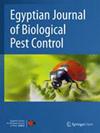Insights into sublethal effects of Metarhizium anisopliae on the biotic potentials of Spodoptera frugiperda (J. E. Smith) (Lepidoptera: Noctuidae) on maize
IF 2.1
3区 农林科学
Q1 ENTOMOLOGY
引用次数: 0
Abstract
Abstract Background Entomopathogenic fungi are an important biological agent in integrated pest management, playing a critical role in controlling insect populations. In the present study, the sublethal effects of the entomopathogenic fungus, Metarhizium anisopliae (Ascomycota: Hypocreales), were investigated on the biotic potential of Spodoptera frugiperda (J. E. Smith) (Lepidoptera: Noctuidae), which is a major pest of economically important crops. Results Obtained results revealed that exposure to LC 50 concentration of M. anisopliae resulted in a significantly longer larval developmental time (3.25–6.45 days) than the control group (2.42–5.49 days). Similarly, pupal duration was longer in the LC 50 treatment (8.24 days) than in the control (6.91 days). Adult longevity was also significantly reduced in the LC 50 (9.64 days) and LC 30 (10.49 days) treatments compared to the control group (11.7 days). The number of eggs laid by female S. frugiperda exposed to LC 50 value of M. anisopliae during the immature stages was significantly lower (464.79 eggs) than that in the control groups (696.93 eggs). Furthermore, all population and age-stage-specific parameters were significantly affected by the sublethal exposure to M. anisopliae at LC 30 and LC 50 values. Conclusion These results suggest that sublethal exposure to M. anisopliae negatively impacts the life table parameters of S. frugiperda . However, the use of M. anisopliae at sublethal levels may have potential benefits for integrated pest management strategies seeking to reduce the use of chemicals.金龟子绿僵菌对玉米夜蛾(鳞翅目:夜蛾科)生物潜能的亚致死效应
摘要背景昆虫病原真菌是害虫综合治理中重要的生物制剂,在昆虫种群控制中起着至关重要的作用。本文研究了昆虫病原真菌金龟子绿僵菌(Metarhizium anisopliae,子囊菌纲:Hypocreales)对我国重要经济作物的主要害虫——狐尾蛾(Spodoptera frugiperda, j.e. Smith,鳞翅目:夜蛾科)的亚致死效应。结果暴露于LC - 50浓度的绿僵菌,其幼虫发育时间(3.25 ~ 6.45 d)显著长于对照组(2.42 ~ 5.49 d)。同样,lc50处理的蛹持续时间(8.24 d)也比对照组(6.91 d)长。与对照组(11.7天)相比,LC 50组(9.64天)和LC 30组(10.49天)的成年寿命也显著缩短。未成熟期暴露于绿僵菌LC 50值下的雌果螨产卵数(464.79个)显著低于对照组(696.93个)。此外,所有种群和年龄阶段特异性参数在LC 30和LC 50值时均受到亚致死暴露的显著影响。结论亚致死暴露对金绿僵菌的生命表参数有负面影响。然而,在亚致死水平使用绿僵菌可能对寻求减少化学品使用的综合虫害管理战略有潜在的好处。
本文章由计算机程序翻译,如有差异,请以英文原文为准。
求助全文
约1分钟内获得全文
求助全文
来源期刊
CiteScore
4.90
自引率
16.70%
发文量
128
审稿时长
>12 weeks
期刊介绍:
The Egyptian Journal of Biological Pest Control is a periodic scientific journal published by the Egyptian Society for Biological Control of Pests (ESBCP) in collaboration with SpringerNature. The journal aims to publish internationally peer-reviewed, high-quality research articles in the field of biological and integrated pest control (non-chemical control). The journal publishes review articles, original papers, conference reports, book reviews, editorials, laboratory reports, technical notes and short communications.

 求助内容:
求助内容: 应助结果提醒方式:
应助结果提醒方式:


